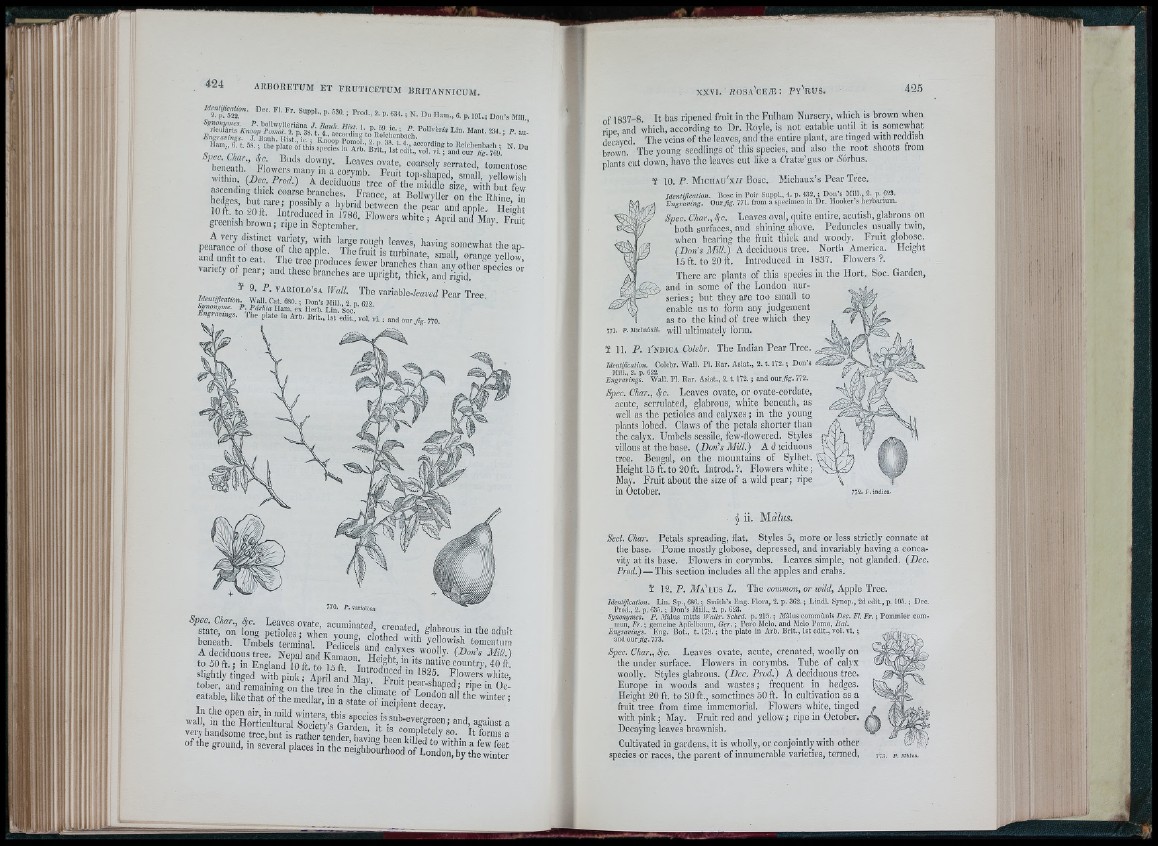
I , li
En¡
p. 530. ; Pro,,., 2. „. C34. ; N. D„ I-I,™„ «. p.
Itam 0. ,. 38.; u.„ pl.a.o J f.in ’s s p e c S L T ? / IV',’. . n i f 'o a i l . ! ¥ l [ t ? " "
• l i t S r v .p T “’,! I'l«“ «"«» .ta iJir .T j i “ hJj
7& j ; 's: s i ',ra,t"s r - “ •"; ■'-
t e r x S S H I r ”
^ ,V Tl’e variable-%a!.p(! Pear Tree
Iite>U,ficat,o„. -Wall. r a t. 080. ; Don's Mill 2 n 022
S</,w„,„„e. P. P dikia Ham. e i Herb. Lin Soc
in s r«m „ g s . Ih e plate In Arb. Brit., 1st eOit.', vol. vi. ; and 0U rJig .n o .
770. P . variolosa.
beneath. Umbels terminal, pflieefs’ and r ? l v ? f J® owish tomentum
A deciduous tree. Nepal and Ka“ iiei®lH?n
to 50 f t . ; in England 10 ft. to IS ft. I n t r o ? ' ? ? ? “ -
slightly tinged with pink ; April and May. R u J t r ' ? ® ’
tober, and remaining on the tree in the climate in Oceatable.
like that of the medlar, in a state of , » “ * “ LJi xinucciippiieenntt ddeeccaayy.! ’
waii:
vftdiandsome tree, but is rather L nder, havin« been k Z d ? ^ ®?i‘ • ‘ “
of the ground, in several places in the -fg lZ u r 'h rd r f l^ ^ ^ ^ ^ ^ ^ ^
Linst a
■ms a
of 1837-8. I t has ripened fruit in the Fulham Nursery, which is brown w ftn
rine and which, according to Dr. Hoyle, is not eatable until it is somewhat
ilecaved. The veins of the leaves, and the entire plant, are tinged with reddish
brown. The young seedlings of this species, and also the root shoots from
plants cut down, have the leaves cut like a Cratæ'gus or Sorbus.
¥ 10. P. M i c i i a u 'x í í Bosc. Michaux’s Pear Tree.
JdenUfication. Bosc tn Poir Suppl., 4. p. 432. ■ Don’s Mill. 2. p. C23.
E n g rm m g . Our Jig. 771. from a specimen in D r. Hooker's herbarium.
Spec. Char., Sfc. Leaves oval, quite entire, acutish, glabrous on
both surfaces, and shining above. Peduncles usually twin,
when bearing the fruit thick and woody. F ruit globose.
{Boris Mill.) A deciduous tree. North America. Height
15 ft. to 20 ft. Introduced in 1837. Flowers?.
There are plants of this species in the Hort. Soc, Garden,
and in some of the London nurseries
; but they are too small to
enable us to form any judgement
as to the kind of tree which they
771. r. Mtciiafaii. vvill ultimately form.
¥ 11. F . i ' n d i c a Cofcir. The Indian Pear Tree.
Jdentification. CC olebr. Wall. PI. Bar. Asiat., 2. 1 .172. ; Don’s
Mill., 2. p. G22.
Engravings. Wall. PI. Rar. Asiat., 2. t. 172. ; and our^g-. 772.
Sj)ec. Char., <§•{?. Leaves ovate, or ovate-cordate,
acute, serrulated, glabrous, white beneath, as
well as the petioles and calyxes; in the young
plants lobed. Claws of the petals shorter than »
the calyx. Umbels sessile, few-flowered. Styles »Wy
villous at the base. {Don's Mill.) Adiciduoiis v v
tree. Bengal, on the mountains of Sylhet.
Height 15 ft. to 20 ft. Introd. ?. Flowers w hite;
Ma}'. Fruit about the size of a wild pear; ripe
in October. 772. F . indica.
§ ii. Mfl7w5.
Sect. Char. Petals spreading, flat. Styles 5, more or less strictly connate at
the base. Pome mostly globose, depressed, and invariably having a conca-
vit)' at its base. Flowers in corymbs. Leaves simj)le, not glanded. {Dec.
Prod.) — This section includes all the apples and crabs.
If 12. P. A T a ' l u s L. The common, or wild, Apple Tree.
Identification. Lin. Sp., 68fi. ; Smith’s Eng. Flora, 2. p. 362. ; Lindl. Synop., 2d edit., p. 105. ; Dec.
Prod., 2. p. 63.5. ; Don’s Mill., 2. p. 623.
Synonymes. P. J/àlus mitis Wallr. Sched. p. 215. ; A/àlus coramilnis Dec. Fl. Fr. ; Pommier com-
iniin, Fr. ; gemeine Apfelbaiim, Ger. ; Pero Melo, and Melo Pomo, Ital.
Engravings. Eng. Bot., t. 179. ; the plate in Arb. Brit., 1st edit., vol. vi. ;
and our jig. 773.
Spec. Char., 4’C. Leaves ovate, acute, crenated, woolly on
the under surface. Flowers in corymbs. Tube of calyx
woolly. Styles glabrous. {Dec. Prod.) A deciduous tree.
Europe in woods and wastes ; frequent in hedges.
Height 20 ft. to 30 ft., sometimes 50 ft. In cultivation as a
fruit tree from time immemorial. Flowers white, tinged
with pink ; May. Fruit red and yellow ; ripe in October.
Decaying leaves brownish.
Cultivated in gardens, it is wholly, or conjointl)7 with other
if)
species or races, the parent of innumerable varieties, termed,
77.5. P. Wfeiua.